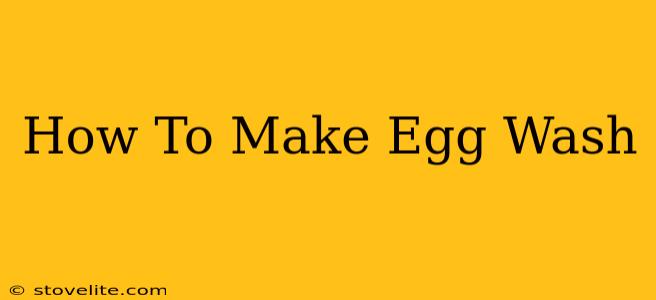Egg wash. That magical ingredient that gives baked goods a beautiful golden-brown sheen and a subtly richer flavor. But what is egg wash, and how do you make it perfectly every time? This comprehensive guide will walk you through everything you need to know, from basic techniques to advanced tips and tricks.
What is Egg Wash?
Egg wash is simply a mixture of beaten eggs (or egg yolks) and a liquid, usually water or milk. This simple mixture is brushed onto pastries, breads, and other baked goods before baking, resulting in a glossy finish and enhanced flavor. It's a crucial step for many recipes, adding both aesthetic appeal and a touch of culinary magic.
Why Use Egg Wash?
There are several compelling reasons to incorporate egg wash into your baking routine:
- Enhanced Browning: Egg wash promotes a rich, golden-brown color on your baked goods. This is due to the proteins in the egg reacting to the heat in the oven.
- Improved Texture: It contributes to a slightly crisp and shiny exterior, adding textural complexity to your creations.
- Flavor Enhancement: The subtle eggy flavor adds a depth of richness that complements many baked goods.
- Better Glaze: It serves as a base for other glazes and toppings, helping them adhere better to the surface.
How to Make Egg Wash: The Basic Recipe
The simplest egg wash recipe is incredibly easy. You'll need:
- 1 large egg: Use fresh eggs for best results. Room temperature eggs are easier to whisk and blend smoothly.
- 1 tablespoon water or milk: Water produces a glossier finish, while milk adds a slightly richer color and flavor. Experiment to see which you prefer!
Instructions:
- Crack the egg: Gently crack the egg into a small bowl.
- Whisk: Whisk the egg vigorously with a fork until the yolk and white are fully combined and slightly frothy. Don't over-whisk; a few seconds is all it takes.
- Add liquid: Add the water or milk and whisk briefly to combine.
- Strain (optional): For an extra smooth and lump-free wash, strain the mixture through a fine-mesh sieve. This removes any bits of egg white that might otherwise create imperfections on your baked goods.
Advanced Egg Wash Techniques: Taking it to the Next Level
Once you've mastered the basics, you can experiment with variations to achieve different results:
Egg Yolk Wash: For a richer, deeper golden-brown color, use only the egg yolk. This produces a more intense color and a slightly richer flavor than a whole egg wash.
Milk Wash: For a milder flavor and a less glossy finish, use milk alone. This option is great for recipes where a subtle shine is preferred.
Cream Wash: For an extra rich and luxurious sheen, use heavy cream instead of milk or water. This results in a beautiful, glossy finish and a slightly richer flavor.
Applying Egg Wash: Tips for Success
- Use a pastry brush: A soft pastry brush is the ideal tool for applying egg wash evenly.
- Apply lightly: Avoid over-brushing, as this can lead to a soggy crust. One thin coat is usually sufficient.
- Let it rest: Allow the egg wash to sit for a few minutes before baking. This helps it adhere better to the surface and develop a deeper color.
Troubleshooting Common Egg Wash Problems
- Egg wash is too thick: Add a little more water or milk to thin it out.
- Egg wash is too thin: Add a little more egg to thicken it.
- Egg wash isn't browning enough: Ensure your oven temperature is correct, and consider using an egg yolk wash for a richer color.
With these tips and techniques, you'll be able to create beautifully browned and flavorful baked goods every time. So grab those eggs and get baking! Happy baking!

